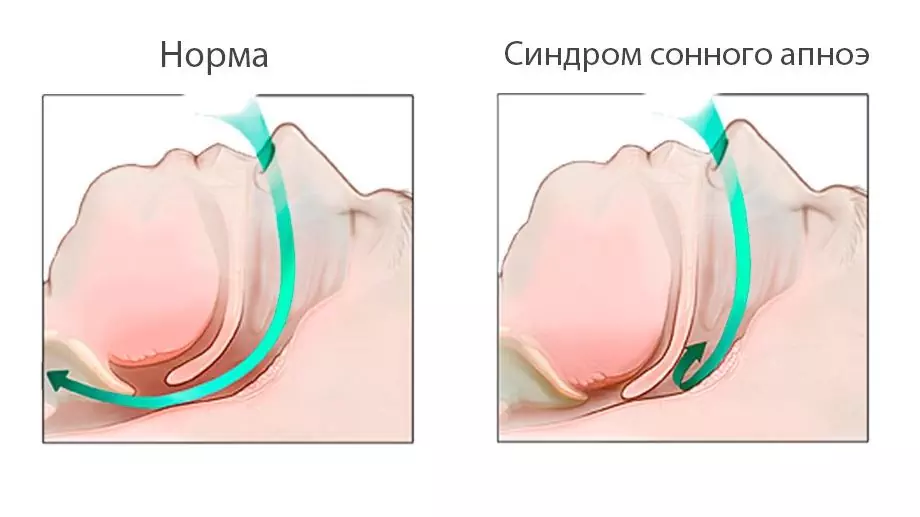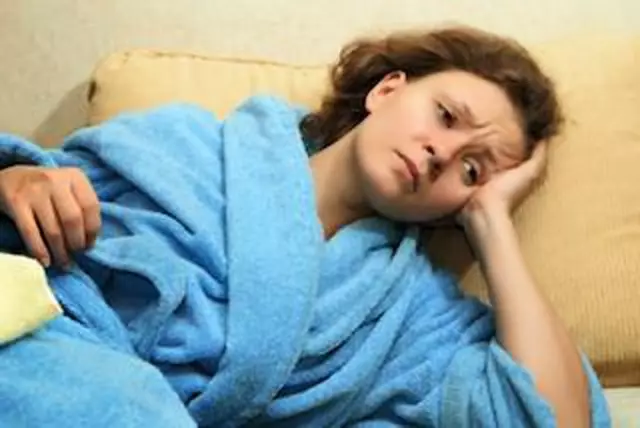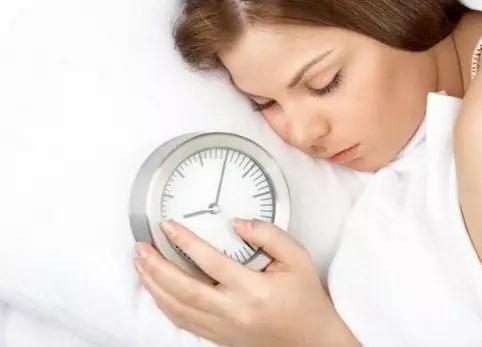- Author Rachel Wainwright [email protected].
- Public 2023-12-15 07:39.
- Last modified 2025-11-02 20:14.
Sleep apnea
The content of the article:
- Causes and risk factors
- Forms of the disease
- Symptoms
- Diagnostics
- Treatment
- Possible complications and consequences
- Forecast
- Prevention
Sleep apnea is a pathological condition that is manifested by breathing disorders that suddenly occur during sleep. Apnea episodes can last from several seconds to several minutes, which negatively affects all internal organs, and especially the central nervous system.
Sleep apnea is a common condition that affects at least 6% of the adult population. The incidence increases with age.

Blocked airway in sleep apnea
Causes and risk factors
The most common cause of sleep apnea is airway obstruction, which is the mechanical closure of the airway (obstructive sleep apnea). During sleep, muscle tissue relaxes, the walls of the pharynx begin to sag inward. At the same time, they not only interfere with breathing, but also vibrate under the influence of an air jet, which we perceive as snoring. However, if the walls of the pharynx sag strongly enough, they will block the lumen of the airways, as a result of which breathing will stop.
Against the background of apnea in the blood, the partial pressure of carbon dioxide, irritating the respiratory center, sharply increases. As a result, the brain "wakes up" and gives the command to increase muscle tone. These processes are repeated many times during sleep.
Predisposing factors of obstructive sleep apnea syndrome include:
- elderly age;
- smoking;
- chronic inflammatory processes in the oropharynx;
- anomalies in the structure of the facial skeleton;
- obesity.
Another cause of sleep apnea is dysregulation of respiratory movements by the central nervous system. Under the influence of certain reasons, during sleep, the brain stops sending nerve impulses to the respiratory muscles, which leads to respiratory arrest. This pathology can lead to:
- stroke;
- hypoglycemia;
- epilepsy;
- water and electrolyte disturbances;
- prematurity in a child;
- some medications;
- cardiac arrhythmia;
- hyperbilirubinemia;
- septic conditions;
- severe anemia.

Upper airway obstruction is a major cause of sleep apnea
Forms of the disease
Based on the reason underlying the pathological mechanism, there are:
- obstructive sleep apnea;
- central sleep apnea.
Depending on the number of episodes of respiratory arrest in 1 hour (apnea index), obstructive sleep apnea is:
- light (5-15 apnea);
- moderate (16-30 apnea);
- severe (over 30 apnea).
Symptoms
The main symptom of any form of sleep apnea is repeated episodes of sudden respiratory arrest during sleep. However, each form of the disease has its own characteristics.
Obstructive sleep apnea is characterized by:
- heavy snoring;
- episodes of sudden cessation of snoring and breathing, lasting from 10 seconds to 3 minutes;
- restoration of breathing, which is accompanied by a characteristic noise or snoring.
With prolonged apnea, hypoxia develops. Then cyanosis of the nasolabial triangle becomes noticeable. During apnea episodes, the patient tries to inhale by contracting the abdominal and chest muscles.
With obstructive sleep apnea syndrome, patients often wake up in the morning unrespirated, during the day they feel overwhelmed, drowsy, apathetic, lethargic. Decreased working capacity.

Severe snoring and episodes of sudden respiratory arrest are the main symptoms of sleep apnea
In severe obstructive sleep apnea, a person often experiences bouts of overwhelming sleepiness during the day. At such moments, patients suddenly fall asleep and wake up after a short period of time (from a few seconds to several minutes). These sudden falls asleep are very dangerous, especially if they occur while driving or performing other activities that require concentration and responsiveness. Moreover, the patients themselves do not notice their "blackouts".
Sleep apnea of central genesis is manifested by the occurrence of Cheyne-Stokes-type breathing during sleep. For the named type of breathing, periodicity is characteristic: respiratory movements from slow and very superficial ones gradually intensify, become noisy, deep, frequent, and then the intensity of respiration fades away again, up to a short stop. As a result, with central sleep apnea, the patient breathes intermittently and noisily. Snoring is not common in all cases. The main distinguishing feature of central apnea in comparison with obstructive apnea is the absence of respiratory movements of the chest and anterior abdominal wall during episodes of respiratory arrest.
Diagnostics
Sleep apnea can be suspected if at least three of the following symptoms are present:
- episodes of respiratory arrest during sleep;
- Loud snoring;
- increased urination at night;
- not restful night sleep;
- increased sweating during sleep;
- attacks of suffocation during sleep;
- headaches in the morning;
- constant feeling of tiredness, daytime sleepiness;
- increased blood pressure, especially in the morning and at night;
- decreased libido;
- overweight.
The "gold standard" for diagnosing sleep apnea syndrome is polysomnography. This is a non-invasive study, during which physiological parameters of night sleep are recorded using special sensors:
- body position in a dream;
- snoring sound phenomenon;
- oxygenation of the blood (saturation);
- features of chest and abdominal breathing;
- features of nasal breathing.

Polysomnography records physiological parameters of night sleep
During this research, the following are also carried out:
- electrocardiography;
- electromyography;
- electrooculography;
- electroencephalography.
Computerized pulse oximetry can be used to screen for sleep apnea syndrome. To carry it out, a special attachment is put on the patient's finger, and a bracelet is placed on the wrist. During a night's sleep, the device determines the heart rate and oxygen content in the blood (saturation).
Treatment
Therapy for mild obstructive sleep apnea includes the following:
- normalization of body weight, if it is above normal;
- treatment, including surgery, of diseases of the ENT organs;
- the use of intraoral devices that allow you to maintain the lower jaw in the correct position and prevent tongue retraction;
- positional sleep apnea therapy - the head end of the bed is raised 15 °;
- the use of devices that do not allow the patient to sleep on his back, that is, in a position that increases the intensity of snoring and the frequency of respiratory arrest;
- cessation of taking tranquilizers, muscle relaxants and hypnotics;
- quitting smoking and drinking alcohol;
- performing breathing exercises;
- compliance with the daily routine.
For moderate and especially severe obstructive sleep apnea syndrome, CPAP therapy is the only effective treatment. This is a hardware technique based on the creation and maintenance of constant positive pressure in the airways.

CPAP therapy is used to treat moderate to severe sleep apnea
Treatment for central sleep apnea consists of drugs that stimulate the respiratory center in the brain. If they are ineffective, a long course of CPAP therapy is performed.
Possible complications and consequences
Sleep apnea syndrome can provoke the development of dangerous diseases:
- arterial hypertension;
- type 2 diabetes mellitus;
- cerebral stroke;
- ischemic heart disease;
- myocardial infarction;
- cardiovascular insufficiency;
- atrial fibrillation;
- immunodeficiency state;
- obesity.
Sleep apnea and snoring bring a lot of discomfort to life, leading to psycho-emotional problems, including in the family.
Sleep apnea is dangerous for pregnant women. Its consequences can be:
- arterial hypertension;
- fetal hypoxia;
- gestational diabetes mellitus;
- gestosis (late pregnancy toxicosis);
- premature birth.
Forecast
With CPAP therapy, sleep apnea stops; most patients notice significant improvement from the first night. Patients need psychological support, since the treatment is carried out for a long time, sometimes for life, and sleeping with the CPAP device is not always convenient and aesthetic.
Prevention
Sleep apnea prevention includes:
- maintaining a normal body weight;
- quitting smoking and drinking alcohol;
- playing sports;
- timely treatment of diseases of the ENT organs;
- compliance with the daily routine;
- refusal from long-term use of sleeping pills.
YouTube video related to the article:

Elena Minkina Doctor anesthesiologist-resuscitator About the author
Education: graduated from the Tashkent State Medical Institute, specializing in general medicine in 1991. Repeatedly passed refresher courses.
Work experience: anesthesiologist-resuscitator of the city maternity complex, resuscitator of the hemodialysis department.
The information is generalized and provided for informational purposes only. At the first sign of illness, see your doctor. Self-medication is hazardous to health!






